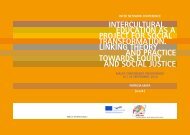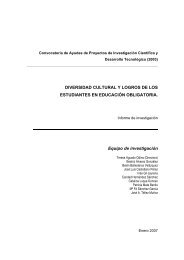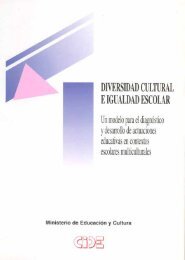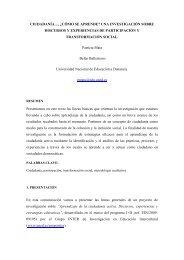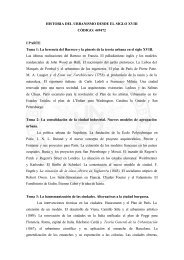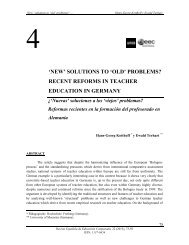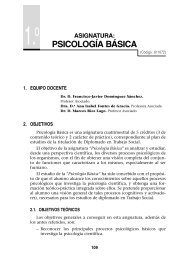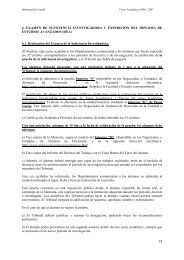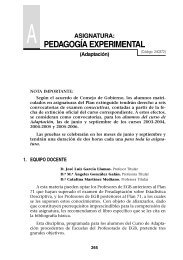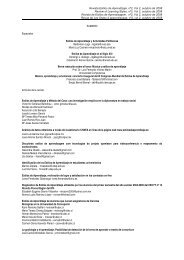Racism: What It Is and How to Deal with It - Uned
Racism: What It Is and How to Deal with It - Uned
Racism: What It Is and How to Deal with It - Uned
You also want an ePaper? Increase the reach of your titles
YUMPU automatically turns print PDFs into web optimized ePapers that Google loves.
A Guide <strong>to</strong> Talking about <strong>Racism</strong> | 44<br />
<strong>Racism</strong> is a dynamic process that depends on many conditioning fac<strong>to</strong>rs <strong>and</strong><br />
circumstances, both personal <strong>and</strong> social. There are no exclusive causes or<br />
explanations for racism, because the motivations of people, groups, <strong>and</strong> institutions<br />
are different; however, we have risked identifying a series of justifications that can<br />
help <strong>to</strong> explain racist behavior..<br />
“We are all tempted by racism. All of us have <strong>with</strong>in us fertile ground ready <strong>to</strong> receive<br />
<strong>and</strong> allow the seed <strong>to</strong> germinate as soon as we let our guard down.”<br />
Albert Memmi 14<br />
2.1 The tendency <strong>to</strong> simplify<br />
We all function cognitively <strong>with</strong> stereotypes <strong>and</strong> we establish categories; this is a<br />
psychological mechanism that helps us <strong>to</strong> simplify reality <strong>and</strong> <strong>to</strong> be able <strong>to</strong> function<br />
in a more agile way in our daily lives.<br />
“Clichés, set phrases, adhering <strong>to</strong> conventions, st<strong>and</strong>ardized codes of<br />
behavior <strong>and</strong> expression fulfill the socially acknowledged function of<br />
protecting us from reality, that is from the dem<strong>and</strong>s that all the events <strong>and</strong><br />
facts make on our thinking attention in virtue solely of their existence. If we<br />
were always aware of this dem<strong>and</strong>, we would soon be exhausted. ”<br />
Hannah Arendt 15<br />
Although this is the way that social cognition works, we must realize that it is also the<br />
starting point for the racist mechanism.<br />
The emphasis on difference <strong>and</strong> not sameness distances us from those people or<br />
groups that we categorize as “others.” By establishing categories, we are inevitably<br />
making value judgments that lead <strong>to</strong> a different way of considering each social group,<br />
that is, <strong>to</strong> creating a hierarchy. This differentiation <strong>and</strong> classification can “blind” us <strong>to</strong><br />
trying <strong>to</strong> get <strong>to</strong> know the other. We take knowledge (either based on previous<br />
experiences or using stereotypes about social groups) that annuls our capacity <strong>to</strong> see<br />
who is there. We simply apply the “cliché” <strong>and</strong> go on <strong>to</strong> consider the person an<br />
individual of class A or class B, <strong>with</strong>out really getting <strong>to</strong> know them. And this lack of<br />
knowledge makes us afraid of the other, it provokes a lack of trust <strong>and</strong> rejection on<br />
our part; or, on the contrary, it provokes admiration <strong>and</strong> liking.<br />
In the case of immigrants, one of the groups that is a victim of racism, we find that<br />
there are different aspects that are valued one way or another (hierarchy), resulting –<br />
in some cases- in discrimination: according <strong>to</strong> the IOÉ Collective 16 , the main criteria of<br />
differentiation are the following:<br />
14 MEMMI, A. (2000). <strong>Racism</strong>. Minnesota: University of Minnesota Press, pág. 23.<br />
15ARENDT, H. (1995). De la His<strong>to</strong>ria a la acción. Paidós, I.C.E. U.A.B.<br />
16 Colectivo IOÉ. “Actitudes ante los inmigrantes: ¿discriminación o tra<strong>to</strong> igualitario?”, in Revista Sal Terrae<br />
Nº 1045, 2001, pp. 379-395. Available also at www.nodo50.org/ioe



